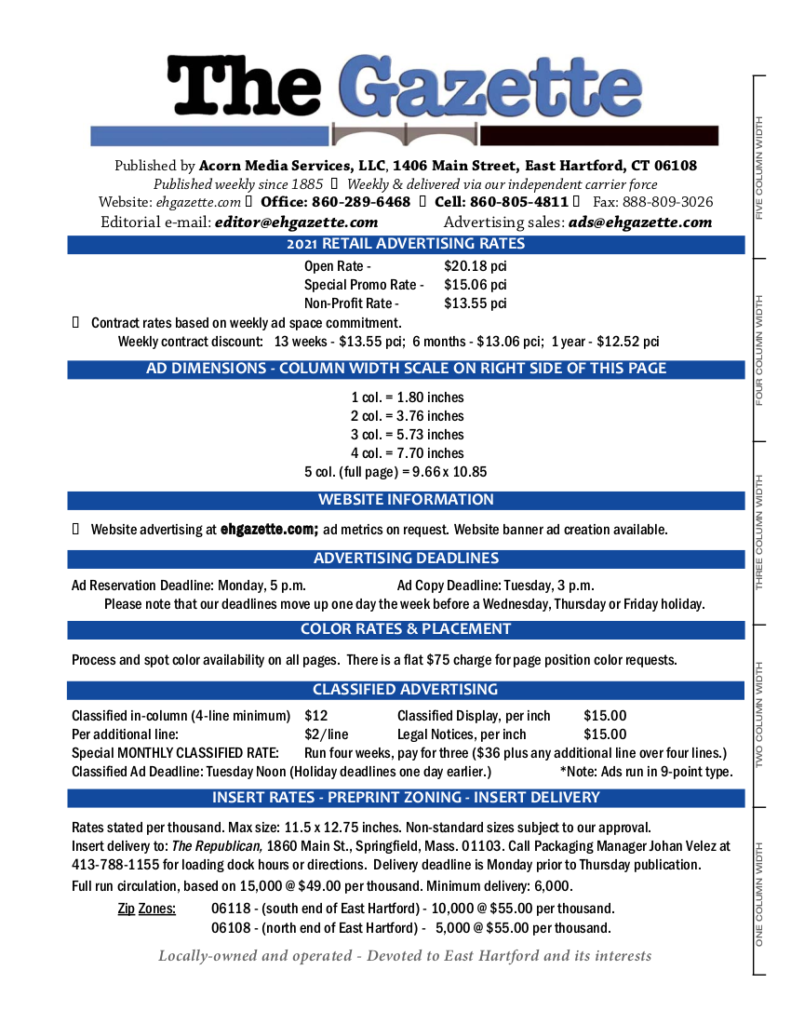Since its founding by 21-year-old Henry Hale and his wife at their home on Wells Avenue, East Hartford in 1885, the weekly East Hartford Gazette has served its community and region as a source of news and information about the people, businesses and issues of import to their lives.
Our mailing address is: The Gazette, 1406 Main Street, East Hartford, Connecticut 06108. E-mail obituaries and other announcements to: editor@ehgazette.com. Please attach photos as jpegs to the e-mail. All Advertising and Classified e-mails should go to ads@ehgazette.com. Our office telephone is 860-289-6468. The toll-free fax number is 888-809-3026. The Gazette also maintains a Facebook page- ehgazette. Please ‘friend’ us. You will be friending Bill Doak, editor, a life-long resident and Gazette editor since 1987.
Here is our current Advertising rate information:

A little about East Hartford: East Hartford’s growth as a place of industry and commerce owes much to its geography. Located where several major transportation arteries serving New England intersect, the town boasted that it sat at “The Crossroads of New England” as it grew rapidly in the early 1950s, transformed by both the then-new federal highway system which saw interstate 84 (then 86), 91 and route 2, 15 and now I-384 built. As one of Hartford’s first suburbs, East Hartford was always a fertile town, first as the breadbasket for the city of Hartford, then for industry as the Hockanum river powered paper mills and factories supplying the American Revolution and Civil War. Today East Hartford is headquarters of Pratt & Whitney Aircraft, home of the 40,000-seat P&W Stadium at Rentschler (pronounced ‘Wrench-ler’) Field, and Goodwin University.
There are approximately 50,000 residents in East Hartford, in reality making its 18-square-miles a small New England city. East Hartford is often called ‘diverse’ and perhaps deservedly so for all the qualities diversity brings to the table in today’s world. Change is often a criticism one hears with regret. However change is a constant in all our lives, and while we may long for the days of yore, adapting to change is what we must do to progress and advance. The reality is the values and aspirations of East Hartford’s residents remain true to the many generations who have called our town home since its founding. East Hartford is still proud of being a ‘town’, thanks to having a “Town”, not a city charter. But thanks to our location directly across the river from Connecticut’s capitol, a major city, urban concerns and the vibrancy of the city are never distant. When one sits at the crossroads, one needs to speak several languages. That has been the case since the time when nomadic Podunk tribes encountered the Reverend Thomas Hooker’s people as they passed through to Hartford where Dutch trader and explorer Adriaen Block established the House of Hope in 1633 along the Quinni-tukq-ut, or long tidal, river.
East Hartford is home to one of the best secondary high schools in the nation, the Connecticut IB Academy, and has been a model community, in many ways, in public education and leadership from its alliance with the University of Connecticut’s NEAG School of Education to the innovative approaches to teaching evident in the recent COVID-19 pandemic. Trinity College, located in Hartford, the University of Hartford, Manchester Community College, Capitol Community College and St. Joseph’s University are nearby and Central Connecticut State University, UConn, Tunxis Community College within a short commute. The same good people in our churches, our civic groups, and our businesses and government leaders are found with rakes or at community events, hands-on, volunteering, awarding scholarships. It is that core of people that helps keep us as if we are a small town in a big city.
Transportation continues to play a role in where East Hartford positions itself. Adjacent to the stadium at Rentschler Field, the former airfield where Charles Lindbergh and Amelia Earhart tested their airplane engines is being marketed as a warehouse and logistics center. The town is not only served by the CT Fastrak bus system, working rail corridors and close proximity to Brainard and Bradley International airports, the transportation highways of the future – fiber optic data lines – have their nexus in East Hartford connecting engineers with not-so-far-flung production lines and factories around the globe. Connectivity, reliability, dependability. East Hartford, which began as Hartford’s breadbasket is now a fertile place of ideas and innovation. In keeping with tradition, it is not immodest to boast that East Hartford, from what the Gazette has witnessed over time, likely will continue to change and progress, to ultimately serve as a rich place where seeds can be planted, nourished with care, then grow to be the future for all.
